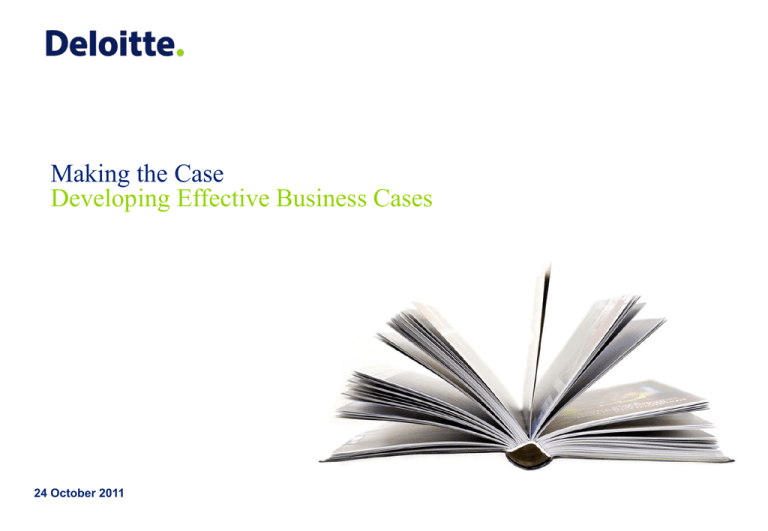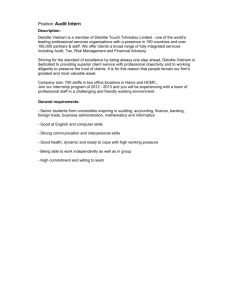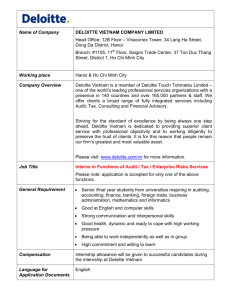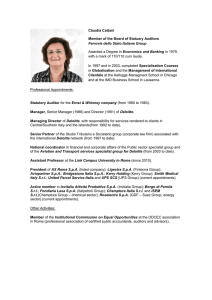
Making the Case
Developing Effective Business Cases
24 October 2011
Agenda
Introduction
2 mins
Who are Deloitte?
3 mins
What is a Business Case and why is it important?
10 mins
What happens when business cases fail?
5 mins
A journey through the Business Case lifecycle
•Identifying the need for change
5 mins
•Analysing the options and defining the final approach
5 mins
•Determining benefits and costs
5 mins
•Assessing the impact of project/business
5 mins
•Presenting the findings and completed business case
5 mins
•What happens once the business case is approved?
5 mins
Wrap up/Questions
2
Developing Effective Business Cases
15 mins
© 2011 Deloitte MCS Limited. Private and confidential
Introduction
Noel Duggan
•
Graduated from QUB in 2009 with a BSc in Accounting & Information
Systems
•
Joined Deloitte in September 2009
•
Part of the Technology team in Belfast
•
What have I been doing?
• Assisted in the implementation of a major payments and accounting system for a
government client in Northern Ireland.
• Worked with a global entertainment provider in London, helping to improve its sales
forecasting and reporting systems.
• Currently working as part of a very large Deloitte team modernising the IT
infrastructure for a Large Aerospace Manufacturer.
3
Developing Effective Business Cases
© 2011 Deloitte MCS Limited. Private and confidential
Who are Deloitte?
Some key facts
•
Often referred to as one of the “Big 4” Professional Services firms
•
Deloitte is an LLP with more than 690 Partners
•
23 recruiting offices in the UK, 140 globally
•
Over 12,000 staff in the UK and 169,000 globally
•
One of the largest private sector graduate recruiters in the UK, (1,100 recruits per
year)
•
Our clients are amongst the UK’s largest and best known companies (FTSE100 and
250)
•
We came second in the Times Top 100 Graduate Employers 2011 for the 7th
consecutive year
•
£1.95 billion revenue in 2010, of which consulting contributed 24%
•
£10,000,000 contributed to community programmes in the UK in 2010
4
Careers in Consulting
© 2011 Deloitte MCS Limited. Private and confidential
What is a business case?
What is a business case?
Definitions of a Business Case
“The business case presents clearly information necessary to support a series of decisions. These decisions, over time,
increasingly commit an organisation to the achievement of the outcomes or benefits possible as a result of investment in business
change” - Source OGC
“The business case is a management tool and is developed over time as a living document as the proposal develops. The
Business Case keeps together and summarises the results of all the necessary research and analysis needed to support decision
making in a transparent way. In its final form it becomes the key document of record for the proposal, also summarising
objectives, the key features of implementation management and arrangements for post implementation evaluation” - Source HM
Treasury Green Book
Attributes of an effective business case
Business cases serves to:
6
Act as a guide to future
decision making.
Inform those concerned of
project possibilities and
ensure they are streamlined
with overall business strategy.
Demonstrate and highlight
the financial cost/benefit of a
proposed project.
Set out a guide for project
fulfilment and best-practice
guide
Developing Effective Business Cases
© 2011 Deloitte MCS Limited. Private and confidential
What is a business case?
Effective business cases should consider:
Objectives
Effective
Business
Case
Management
Risk
•
•
•
•
•
7
Desirability
Achievability
Affordability
Objectives – What is the project/business seeking to achieve?
Desirability and Achievability – is the project/business worth doing (what are the benefits and do the benefits
outweigh the costs) and is it achievable?
Affordability – Can we afford it?
Risk – What are the risks and how are they to be managed?
Management/ Governance – How, by whom and when the project is to be managed and evaluated?
Developing Effective Business Cases
© 2011 Deloitte MCS Limited. Private and confidential
Why is a business case necessary?
• Creates a climate for idea creation and analysis
• Outlines the issues and risk of a project before implementation
• Identifies financial and business owners of a project; establishes accountability for results
Creates
Discipline
• Provides a step-by-step
approach
• Details future vision post
project implementation
• Highlights the operational
changes necessary to
implement a project
Establish
Direction
Advantages
of a
Business
Case
Provides
Control
• Provides a benchmark
against which project
performance, benefits
and costs can be tracked.
Minimizes
Risk
• Identifies the financial impact of the project/business
• Assesses the impact of the risks and rewards associated with the project/business
8
Developing Effective Business Cases
© 2011 Deloitte MCS Limited. Private and confidential
Who uses business cases?
Everyone!
Government
Industry/Businesses
Individuals
•
•
•
•
• Business
Improvements
• New Ventures
• Investment decision
• Personal
opportunities e.g.
Education (choosing
your degree!),
Career decisions.
9
Central
Local
QUANGO’s
Public services;
Schools, Healthcare,
Police
Developing Effective Business Cases
© 2011 Deloitte MCS Limited. Private and confidential
What happens if business cases
fail?
Example 1: C-NOMIS
A £234m “C-Nomis” IT system for Prisons failed in almost every
possible way...
12 March 2009
Public spending watchdogs attacked spiralling costs and delays in the National
Offender Management information system (C-Nomis)
12 March 2009
C-Nomis was treated as an IT project and not a business-change
programme, project management was poor, and contracts with suppliers
were weak.
12 March 2009
Officials in charge of the scheme - abandoned after costs trebled lacked even a "minimum level of competence", the Public Accounts
Committee found. It highlighted a "culture of over-optimism" and
confidential
lack of "rigorous" scrutiny of the scheme.© 2011 Deloitte MCS Limited. Private3and
Nov
2009
Example 2: The Millennium Dome
“The main cause of [these] difficulties is the failure to achieve the visitor numbers and
income required. The targets were highly ambitious and inherently risky leading to a
significant degree of financial exposure on the project. In addition, the task of managing
the project has been complicated by the complex organisational arrangements put in
place from the outset, and by the failure to establish sufficiently robust financial
management.”
- Sir John Bourn, Comptroller and Auditor General, NAO commenting on the factors contributing
to the financial failure of the Millennium Dome project – Nov 2000
Duds all round: where the
millennium millions sank
© 2011 Deloitte MCS Limited. Private and confidential
October 29, 2006
Example 3: National Programme for IT
‘The project has not delivered in line with the original intent as targets on
dates, functionality, usage and levels of benefit have been delayed and
reduced’
22 September 2011
© 2011 Deloitte MCS Limited. Private and confidential
Journey through the
business case lifecycle.
Business case development approach
Following a stage-by-stage process enables you to create an inclusive, more effective business case ensuring you
cover all the relative and important considerations
Identify need
Stage 1
Evaluate Options
Stage 2
Calculate Costs & Benefits
Stage 3
Conduct Impact Assessment
Stage 4
Present Findings
Stage 5
15
Developing Effective Business Cases
© 2011 Deloitte MCS Limited. Private and confidential
Stage 1: Identify the need
This stage represents a conceptual ‘trigger point’ that creates the need to develop a business case.
In this stage you would expect to consider the business environment and the business’ strategic
vision while considering external and internal challenges and opportunities. Once these have been
considered you will create a selection of potential options.
External
Environment
• Competitor
activities
• Changes in
Government
regulation
SWOT
Strengths
Weaknesses
Opportunities
Identify the need
and create
potential options
Internal
processes
• Are there any
current
deficiencies?
• Current constraints
on business
functions
Threats
PESTLE
Political
Economic
Sociological
Business
Relationships
• Customer
Interaction
• Supplier Interaction
Highlights the internal
and external factors to
consider in a project
This shows the ‘big
picture’
Technological
Legal
Environmental
16
Developing Effective Business Cases
© 2011 Deloitte MCS Limited. Private and confidential
Stage 2: Analyse options
In any given scenario after having identified the need for a project based business plan there are four pathways an
organisation or individual can choose to take prior to analysing the different business plan possibilities
Do nothing
Status-quo
Do minimum
Do something
17
This is where you stop all activity, which does typically have a cost associated with it.
This option should be included as a baseline to compare with the other options.
This is where you continue with the your current processes e.g.
Continuing with the current contract which might have a higher cost than retendering.
It is possible that a non-technical approach could go towards meeting the business need.
This excludes a business case based project approach for larger change project.
This includes:
• Assessing business options (i.e. required business processes and functionality)
• Delivery options e.g. Outsourcing
• Funding options e.g. Joint ventures
Developing Effective Business Cases
© 2011 Deloitte MCS Limited. Private and confidential
Stage 2: Analyse options
A number of options were identified in the Identify Need stage. In this section an initial analysis of these options
will be carried out. This may reduce the need to develop a business case for each option.
Brainstorm
workshop
Filter and streamline ideas removing those which are obviously unfeasible
Risks
Financial
Market
Project
Budgetary
consideration
Ranking and scoring
Cost of doing nothing?
Cost benefit analysis?
Financial
methods
Business targets and
responsibilities
In-line with business
strategy?
Initial Cost?
Evaluation
techniques
Feasibility?
Suitable?
Acceptance?
Conclusion
Developing Effective Business Cases
Create a detailed shortlist of options and select a preferred option
© 2011 Deloitte MCS Limited. Private and confidential
Stage 2: Determine approach
When considering the options you have selected during the Analysis stage you can then choose to approach your
business case project through three methods.
Opportunity Assessment /
Outline Business Case (OBC)
Option Analysis
Full Business Case (FBC)
Establishes the scope and scale of potential
opportunities by:
Establishes the scope and scale of potential
opportunities by:
Establishes the scope and scale of potential
opportunities by:
•
•
•
•
Comparing to benchmarks of other
organisations, best practice, industry body
research, e.g. CIPFA, SOCITM, etc
Agreeing the size of the prize as a range.
Usually done at a high level using overall
numbers rather than detailed analysis, e.g.
total staffing numbers rather than detailed
analysis of work done by each team.
•
Outlining all sensible options agreed with the
client and providing a summary analysis of
each (as for opportunity assessment)
Defining the recommended option and
providing a more detailed analysis of this
option (closer to full business case).
•
Producing a financial analysis of the current
and future positions to provide a detailed
picture of the costs / benefits, e.g. activity
based costing or an analysis of work done by
each team compared with future work
following new system implementation.
Producing a phased benefits case and
implementation plan
Suitable when:
Suitable when:
Suitable when:
•
•
•
•
•
•
The scope/opportunity is not well understood,
i.e. the project is very early in it’s inception
and indicative cost/benefit is required
The project is similar in nature to one carried
out before
The financial benefits are likely to be low (i.e.
the project has non-financial drivers
•
•
Either an Opportunity Assessment or Full
Business Case may be required
A range of potential options need to be
assessed to determine the way forward.
Recommended option is derived from scoring
against agreed criteria, e.g. financial case,
political priorities, service improvement
•
The size of investment is high
The cost/benefit of different options needs to
be well understood
The viability of carrying out the project is in
question
An Outline Business Case document can be as long as or longer than a Full Business Case!
19
Developing Effective Business Cases
© 2011 Deloitte MCS Limited. Private and confidential
Business case stage 3:
Calculate costs and benefits
Stage 3: Determine costs and benefits
Costs and benefits can be categorised into a number of groups and areas to include a range of
business case outcomes.
Benefits
Hard/ monetized factors;
These are the clear financial
aspects to consider when
implementing a project, e.g.
Building costs
Soft/non-monetized factors;
These are the non-financial
aspects a business case must
consider, e.g.
Staff morale, brand and
company reputation.
21
Developing Effective Business Cases
Costs
Hard: Monetized
•Direct Cost
•Fixed costs
•Variable costs
•Implementation
costs
Soft: Nonmonetized
•Indirect costs
•Opportunity
costs
Hard: Monetized
•Direct Benefits
•Indirect benefits
Soft: Nonmonetized
•Direct
•Indirect
© 2011 Deloitte MCS Limited. Private and confidential
Stage 3: Determine benefits
Benefits can be categorised into a number of groups. This enables ease of monitoring and reporting.
• Direct Financial Benefits (Tangible)
‒ Those that can be quantified and valued in financial terms
‒ Examples: Cost savings - reduced number of staff, procurement spend savings, cancelled software
and hardware support contracts. Revenue generation - additional sales.
• Direct Non-Financial Benefits (Tangible)
‒ Those that can be quantified, but are difficult or impossible to value in financial terms e.g. Reduced
reoffending rates
• Indirect Benefits (Intangible or ‘soft’ benefits)
‒ Can be identified, but cannot be easily quantified e.g. end user satisfaction, better access to
information, better organisation image, improved employee morale, better vendor relationships
At this stage we want to focus on the Direct Financial Benefits first
22
Developing Effective Business Cases
© 2011 Deloitte MCS Limited. Private and confidential
Stage 3: Determine costs
Estimate the costs associated with doing the work and the ongoing operation following the change.
For example:
•
•
•
•
•
•
•
•
Design and build costs associated with a new office
Technology implementation costs (hardware, software, implementation, training)
Redundancy costs associated with a re-organisation
Backfill costs for seconded staff
Software maintenance and support
Office leasing costs
Opportunity costs of internal staff (if appropriate)
Consultancy costs!
Make sure you are differentiating between real costs that will impact cash flow and opportunity costs
Remember to factor in any assumed increases in costs, e.g. price / wage inflation
23
Developing Effective Business Cases
© 2011 Deloitte MCS Limited. Private and confidential
Stage 3: Determine costs
Terminology you are likely to encounter:
• Direct vs. indirect costs
‒ Direct costs are directly associated with system, e.g. each call to support vendor costs £1 / call
‒ Indirect costs are not directly associated with specific activity, often referred to as overhead expenses
• Fixed vs. variable costs
‒ Fixed costs are considered as sunk costs. They are always there and do not change in the short
term, regardless of how much or little you produce, e.g. rent, business rates.
‒ Variable costs are incurred on a regular basis and usually proportional to output volume, e.g.
additional labour, overtime
• Capital expenditure (CAPEX) vs. Operating expenditure (OPEX)
‒ CAPEX are expenditures that are incurred outside of the normal day-to-day running of the business
to enable future benefits, e.g. buying fixed assets (equipment, property) or adding to the value of an
existing fixed asset with a useful life beyond the taxable year
‒ OPEX are ongoing costs for running a product, business or system and include the cost of workers
and facility expenses such as rent and utilities
24
Developing Effective Business Cases
© 2011 Deloitte MCS Limited. Private and confidential
Stage 3: Determine non-financial impact
Define the benefits that cannot be assigned a financial value. This should be performed for each
type of business case and forms a key part of the criteria to determine the recommended option.
• State the needs and objectives identified earlier as a set of non-monetary benefits
• Weight each benefit against the needs and objectives
• Construct and populate a scoring matrix, relating each of the options to the non-monetary benefits
• Make clear how each of the options compare in regard to these factors.
Examples:
• Better management information is available to support senior management
• Improved customer satisfaction
‒ Positive survey feedback
‒ Reduced call abandonment rate
• Improved links between ICT and business users resulting in a higher business satisfaction with
delivered projects
25
Developing Effective Business Cases
© 2011 Deloitte MCS Limited. Private and confidential
Business case stage 4:
Conduct impact assessment
Stage 4: Calculate financial impact
The purpose of calculating the financial impact of proposals is to establish that the preferred option is
affordable and financially sustainable and to explore and identify a funding model for the project that
supports sustainable value for money over the lifetime of solution.
Firstly, develop an outline implementation plan taking into account
• Dependencies within the project. i.e. Those stages which depend upon to completion of another
stage in order to begin
• Current constraints, e.g. decision-making delay, resourcing constraints
• External dependencies, e.g. infrastructure changes required prior to a new system
Next, document risks and issues to inform decision making, considering:
• Are the risks too significant to realise the potential benefits?
• Are the costs likely to outweigh the benefits?
• If the costs increase, could we afford to finish it?
• Can we effectively manage these risks?
27
Developing Effective Business Cases
© 2011 Deloitte MCS Limited. Private and confidential
Stage 4: Calculate financial impact
The purpose of calculating the financial impact of proposals is to establish that the preferred option is
affordable and financially sustainable and to explore and identify a funding model for the project that
supports sustainable value for money over the lifetime of solution.
Outline
implementation
plan
28
Developing Effective Business Cases
Document
risks and
issues
Assign
benefits and
costs to
project
phases
Identify
funding
model
Create
financial
schedule
© 2011 Deloitte MCS Limited. Private and confidential
Stage 4: Calculate financial impact
Associate anticipated benefits and costs with milestones on the implementation plan:
• Based on the phasing of the implementation plan, benefits and costs should be associated with
particular milestones. This will support building the financial schedule.
Identify an appropriate funding model
• Work with client Finance staff to identify an appropriate funding model, e.g. retained savings, loans
• Include funding requirements alongside funding sources and highlight any funding gaps
Create the financial schedule
• Each business case should have financial schedule. This will show when costs are incurred and
when benefits are realised, along with the overall financial impact of the project to inform decision
making: e.g. invest to save, affordability, etc.
• For an options assessment, this may need to be done for each option or only the preferred option
(if only one is considered viable)
29
Developing Effective Business Cases
© 2011 Deloitte MCS Limited. Private and confidential
Stage 4: Calculate financial impact
Some typical financial analysis methods include:
• Payback period
• Net Present Value
• Break-even point
• Unadjusted or 'Accounting' Rate of Return (ARR)
• Internal Rate of Return (IRR)
• Discount Rate of Return or Yield
• Benefit/ Cost Ratio
30
Developing Effective Business Cases
© 2011 Deloitte MCS Limited. Private and confidential
Stage 4: Calculate financial impact
Example: Payback Period
£
Payback Period
Time
Initial
investment
Revenue / Benefit
generated from
investment
31
Developing Effective Business Cases
© 2011 Deloitte MCS Limited. Private and confidential
Stage 4: Calculate financial impact
NPV example
The sum of all cash flows of the project discounted back to their present value
(i.e. their value now)
The discount rate =
weighted average cost of capital
NPV > 0 Project worthwhile
NPV < 0 Project not worthwhile
NPV = 0 Breakeven
Advantages
• The time value of money issue is
incorporated
• It is an absolute measure
Disadvantages
• It is difficult to understand
• It is difficult to calculate accurately
• Cost of capital is difficult to estimate
Example
A business case will result in a project that will purchase a £1m ERP system.
The new system will produce £200k of benefit in the first year and £300k for
the next four years. Calculate the NPV.
The cost of capital is 10%.
Year
Y0
Y1
Y2
Y3
Y4
Y5
Capital
Revenue
DF
PV
NPV
32
Developing Effective Business Cases
© 2011 Deloitte MCS Limited. Private and confidential
Stage 4: Calculate financial impact
NPV example
The sum of all cash flows of the project discounted back to their present value
(i.e. their value now)
Steps
Place values into a structured table.
Put capital/investments in a different row
to revenue/benefits.
Remember investments are negative and
revenues are positive.
Example
A business case will result in a project that will purchase a £1m ERP system.
The new system will produce £200k of benefit in the first year and £300k for
the next four years. Calculate the NPV.
The cost of capital is 10%.
Year
Capital
Revenue
Y0
Y1
Y2
Y3
Y4
Y5
£200k
£300k
£300k
£300k
£300k
(£1m)
DF
PV
NPV
33
Developing Effective Business Cases
© 2011 Deloitte MCS Limited. Private and confidential
Stage 4: Calculate financial impact
NPV example
The sum of all cash flows of the project discounted back to their present value
(i.e. their value now)
Periods
Steps
Find the Discount Factors (DF) for each
year.
This can be calculated using the following
formula.
Interest rates r
n
1%
2%
3%
4%
5%
6%
7%
8%
9%
10%
1
0.990
0.980
0.971
0.962
0.952
0.943
0.935
0.926
0.917
0.909
2
0.980
0.961
0.943
0.925
0.907
0.890
0.873
0.857
0.842
0.826
3
0.971
0.942
0.915
0.889
0.864
0.840
0.816
0.794
0.772
0.751
4
0.961
0.924
0.888
0.855
0.823
0.792
0.763
0.735
0.708
0.683
5
0.951
0.906
0.863
0.822
0.784
0.747
0.713
0.681
0.650
0.621
DF = (1+r) – n
Where r = interest rate and n = number of
periods until payment or receipt.
The cost of capital is 10%
HINT:
It is easier to use Present Value Tables
such as the one opposite
34
Developing Effective Business Cases
© 2011 Deloitte MCS Limited. Private and confidential
Stage 4: Calculate financial impact
NPV example
The sum of all cash flows of the project discounted back to their present value
(i.e. their value now)
Steps
Transfer the Discount Factors (DFs) into
the table.
Example
A business case will result in a project that will purchase a £1m ERP system.
The new system will produce £200k of benefit in the first year and £300k for
the next four years. Calculate the NPV.
The cost of capital is 10%.
Year
Capital
Y0
Y2
Y3
Y4
Y5
£200k
£300k
£300k
£300k
£300k
0.909
0.826
0.751
0.683
0.621
(£1m)
Revenue
DF
Y1
1
PV
NPV
35
Developing Effective Business Cases
© 2011 Deloitte MCS Limited. Private and confidential
Stage 4: Calculate financial impact
NPV example
The sum of all cash flows of the project discounted back to their present value
(i.e. their value now)
Steps
Multiply the sum of the capital and
revenue in each column by the DF to
calculate the Present Value (PV).
The PV represents the value that the cash
would be worth in today’s money.
Example
A business case will result in a project that will purchase a £1m ERP system.
The new system will produce £200k of benefit in the first year and £300k for
the next four years. Calculate the NPV.
The cost of capital is 10%.
Year
Capital
Y0
Y1
Y2
Y3
Y4
Y5
£200k
£300k
£300k
£300k
£300k
(£1m)
Revenue
DF
1
0.909
0.826
0.751
0.683
0.621
PV
(£1m)
£182k
£248k
£225k
£205k
£186k
NPV
36
Developing Effective Business Cases
© 2011 Deloitte MCS Limited. Private and confidential
Stage 4: Calculate financial impact
NPV example
The sum of all cash flows of the project discounted back to their present value
(i.e. their value now)
Steps
The NPV is the cumulative sum over the
time period of the PVs.
Example
A business case will result in a project that will purchase a £1m ERP system.
The new system will produce £200k of benefit in the first year and £300k for
the next four years. Calculate the NPV.
The cost of capital is 10%.
The NPV after 5 years is £46k.
Since the NPV is positive, the project is
worth completing.
Year
Capital
Y0
Developing Effective Business Cases
Y2
Y3
Y4
Y5
£200k
£300k
£300k
£300k
£300k
(£1m)
Revenue
37
Y1
DF
1
0.909
0.826
0.751
0.683
0.621
PV
(£1m)
£182k
£248k
£225k
£205k
£186k
NPV
(£1m)
(£818)
(£570)
(£345)
(£140)
£46k
© 2011 Deloitte MCS Limited. Private and confidential
Stage 4: Perform sensitivity analysis
Throughout the life of the project there are risks and uncertainties that can and will materialise.
Sensitivity analysis is a crucial part of a business case which:
• Tests the vulnerability of options to these uncertainties and
• Forecasts the potential impact on the costs / benefits of each option
When performing a sensitivity analysis you should consider and define:
Assumptions
Scenarios
Mitigating
actions
38
• Consider the assumptions that underpin the costs / benefits of each option
and what aspects of these would be sensitive to change
• Define scenarios that represent events which could occur and cause a
deviation from plan
• For each scenario include mitigating actions that could be taken
Developing Effective Business Cases
© 2011 Deloitte MCS Limited. Private and confidential
Stage 4: Perform sensitivity analysis
When conducted a sensitivity analysis you should consider the factors which may distort a realistic
assessment of the current situation and the potential outcome of a project.
People expect positive future events despite lack of evidence
Optimism bias
Optimism bias factors are expected to decrease as a project progresses
Confirmation
bias
Searching/interpreting evidence in a selective manner to support pre-existing
beliefs
Being influenced by peers to believe uncritically that something must be true
Herd mentality
39
Be aware of accepted ‘norms’, culture and ingrained habits
Developing Effective Business Cases
© 2011 Deloitte MCS Limited. Private and confidential
Stage 4: Perform sensitivity analysis
Example: Corporate Jet Building Company
Fig.1 J Curve of Challenger Cash Flow Forecast with Varied Orders
400000
300000
Cumulative Cash ($000s)
200000
100000
0
1975
1976
1977
1978
1979
1980
1981
1982
1983
1984
1985
-100000
-200000
Year
Probable Cumulative Cash Flow
40
Developing Effective Business Cases
Pessimistic Cumulative Cash Flow 40% reduction in sales
Optimistic Cumulative Cash Flow 20% increase in sales
© 2011 Deloitte MCS Limited. Private and confidential
Business case stage 5:
Present findings
Stage 5: Present findings
Document all elements produced in an easy to understand format. The format will differ depending on
the type of business case.
Key sections would typically include:
• Executive Summary and Introduction
• Project Scope and Mandate
• Overview of Future Model or Options
• Benefits, both Qualitative and Quantitative
• Costs
• Project Plan / Milestones
• Financial Schedule
• Assumptions
• Risk Assessment
• Conclusions and Recommendations
42
Developing Effective Business Cases
© 2011 Deloitte MCS Limited. Private and confidential
Stage 5: Present findings
Examples
43
Developing Effective Business Cases
© 2011 Deloitte MCS Limited. Private and confidential
What happens once the
business case is approved?
What happens next?
Benefits
management
Risk
and issue log
strategy & plan
Approved
business case
Project
implementation &
plans
Manage the
delivery of project
products / outputs
Project budget &
funding
Are the costs in
line with the
business case
Change control
Update business
case
Project continues
or stops
45
Developing Effective Business Cases
© 2011 Deloitte MCS Limited. Private and confidential
Business Cases – recap
What have we learned?
• The business case is a key tool used to ascertain
whether a project should go ahead;
• It should also set the basis of targets to assess the
performance of a project in terms of costs (budget),
timescales and benefits.
• It sets a solid foundation upon which a successful
project can be developed
46
Developing Effective Business Cases
© 2011 Deloitte MCS Limited. Private and confidential
Wrap up and close
Any further questions?
47
Developing Effective Business Cases
© 2011 Deloitte MCS Limited. Private and confidential
Deloitte refers to one or more of Deloitte Touche Tohmatsu Limited (“DTTL”), a UK private company limited by guarantee, and its network of member firms, each of which
is a legally separate and independent entity. Please see www.deloitte.co.uk/about for a detailed description of the legal structure of DTTL and its member firms.
Deloitte MCS Limited is a subsidiary of Deloitte LLP, the United Kingdom member firm of DTTL.
This publication has been written in general terms and therefore cannot be relied on to cover specific situations; application of the principles set out will depend upon the
particular circumstances involved and we recommend that you obtain professional advice before acting or refraining from acting on any of the contents of this publication.
Deloitte MCS Limited would be pleased to advise readers on how to apply the principles set out in this publication to their specific circumstances. Deloitte MCS Limited
accepts no duty of care or liability for any loss occasioned to any person acting or refraining from action as a result of any material in this publication.
© 2011 Deloitte MCS Limited. All rights reserved.
Registered office: Hill House, 1 Little New Street, London EC4A 3TR, United Kingdom. Registered in England No 3311052.
Member of Deloitte Touche Tohmatsu Limited
© 2011 Deloitte MCS Limited. Private and confidential




